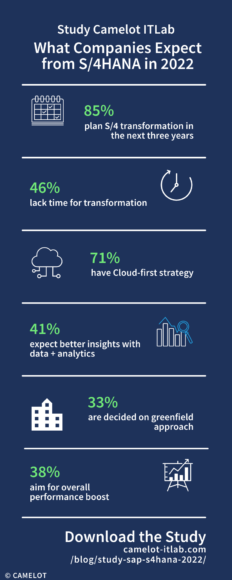More and more companies are focusing their minds on migration to SAP S/4HANA. But what do German companies expect from the S/4 transformation? The article provides insights into the findings of the S/4HANA Migration Study run by Camelot and techconsult.

A SAP S/4HANA migration seems inevitable: in Camelot ITLab and techconsult’s latest study on expectations of SAP S/4HANA, almost 90 percent of the experts surveyed across 200 SAP-using companies indicated that within the coming three years, they would move from their current ERP system to S/4 as the new power motor in SAP’s portfolio.
It is hardly surprising that many companies will migrate to S/4 given the announcement that support for some older ERP versions will end by 2027. The urgency of it all is proven by how many respondents said that the switch will become an issue for them over the next one to three years.
A question arises here: what are German companies expecting from the S/4 changeover? What benefits can be gained? How can companies increase competitiveness via automation or by making better use of data for decision-making?
Higher—Faster—Further: What Companies Expect from the S/4 Migration
Automation, performance optimization, saying goodbye to data silos and central databases, more uniform data management: these were the benefits that topped the wish lists of respondents to the S/4HANA migration study. These responses show that the new ERP system truly has a key role to play in winning competitive advantages and supporting growth strategies.
Automation and Performance Optimization
43 percent of participants in the S/4 migration study expect easier automation of formerly manual processes. This results in major efficiency gains and more effective deployment of resources. Correspondingly, 38 percent of the companies surveyed named performance optimization as a significant advantage.
Uniform Database and Easier Data Management
SAP promises the ability to break down existing data silos during the switchover, and respondents took them at their word: 38 percent of them named it as the benefit they would like to see from S/4 migration. Additionally, 33 percent hope that data models and processes will be easier to deal with. Behind this is an expectation that they will be able to better use inventory data for decision-making and forecasting across all departments of a company. Combined with new solutions built on S/4—such as SAP Analytics Cloud—this makes it even easier for the company to deliver the SAP universe’s value proposition, or they can do it for even more company stakeholders. Respondents see additional benefits when collaboration is simplified via information sharing and they are able to respond more quickly to customers and partners.
S/4HANA Migration—On the Path towards the Intelligent Enterprise
Looking at responses given by study participants, there’s a lot more behind S/4HANA migration than the announcement that support will end for older ERP systems. This is driven by the very specific desire of specialist departments to change business processes. The cumulative weight of responses setting out their hopes for new opportunities in the data mega-trend indicates something new when it comes to working with data: a unified database, simpler data models, and simplified data exchange are becoming the data on which decision-making is based at every point in the enterprise. Automation and process optimization do the rest of the work to increase efficiency and free up time for tasks that add value.
This interpretation also shows that with S/4 migration, many companies are in the middle of a broader transformation, which SAP talks about in terms of the Intelligent Enterprise—a vision that is not merely “data-driven” but which also encompasses trends like sustainability and networking beyond a company’s boundaries. Technologies like predictive analytics and self-learning systems are used in this context.
The S/4 migration thus helps companies achieve medium-term goals that go beyond the narrower interests of specialist departments: more efficient processes, data-driven decisions, and automation. These changes can deliver quicker time-to-market, more agility, and greater resilience—laying the foundation for future competitiveness and more revenue growth.
In the current situation, where many companies are facing change due to supply chain and transport bottlenecks, digitization, and difficulties hiring workers, the switch to S/4HANA won’t solve every problem at the drop of a hat. The various initiatives relevant to the switchover—run by IT, business departments and corporate management—first need time to take effect. This article gives details on possible obstacles to a S/4 transformation.
Secondly, the study’s findings suggest that many companies still need to perform internal preparations. E.g., the findings suggest that the required departmental skills are built up too late, or in the wrong departments. Only during transformation planning do companies realize that stakeholders from the business departments must be involved, alongside management and IT.
RISE with SAP
To support business customers in their wide-ranging transformation into an Intelligent Enterprise, SAP has launched the RISE with SAP program, aimed at all customers regardless of their starting points or the complexity of the upcoming changes. SAP is positioning itself as a partner to customers, providing “Business Transformation as a Service.” The steps required for an efficient and successful transformation are bundled into three stages—and SAP relies on the proven partner ecosystem to implement them.
This blog article provides an overview of the RISE with SAP program.
Study Findings: What to Expect from SAP S/4 transformation
The survey findings in this blog article are taken from the study “Expectations for S/4HANA—Can the Transformation Deliver What Companies Expect?” by Camelot ITLab and techconsult, published in January 2022. For this, the survey questioned decision-makers in C-level management and IT and experts with managerial roles. Respondents came from 200 companies across three size categories and seven industries in Germany:
- What are your implementation plans?
- How are things with the status quo and your transformation planning?
- What transformation challenges do you see?
- What expectations and fears do companies have?
- What do you require from SAP partners?
Click here to Download the free study.

